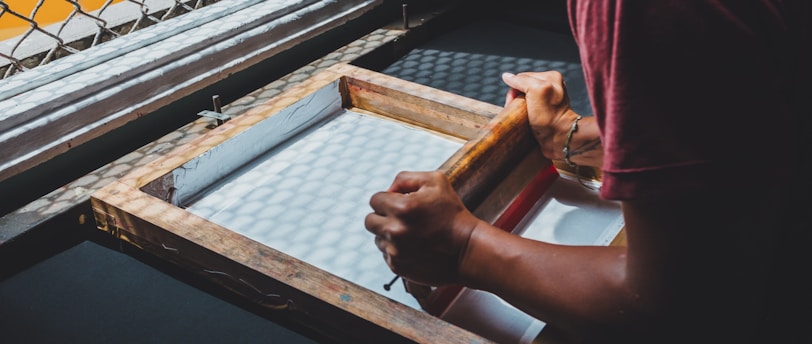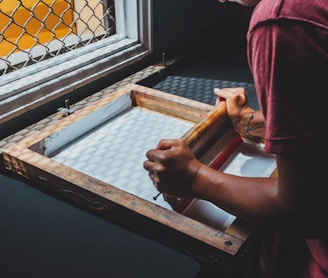Garment Printing: A Comprehensive Guide for Beginners
In this article, we will provide a comprehensive guide for beginners on garment printing, covering everything from the basics to advanced tips and tricks.
CUSTOMIZATION OPTIONS
Saleem Shahzad
5/9/20236 min read


1. Introduction: What is Garment Printing?
Garment printing is the process of applying a design or image onto a piece of clothing, such as a t-shirt, hoodie, or hat. The design can be anything from text to graphics, and the printing can be done using various techniques and materials, depending on the desired effect and durability. Garment printing has become a popular way of creating personalized clothing items for various purposes, such as promotional events, sports teams, charity fundraisers, or personal fashion statements.
2. Benefits of Garment Printing
There are several benefits of garment printing that make it a preferred choice for customizing clothing items:
Personalization: Garment printing allows you to create unique and personalized designs that reflect your brand, message, or style. You can choose the colour, size, and placement of the design, and customize it according to your preferences.
Versatility: Garment printing can be done on a wide range of fabrics and materials, such as cotton, polyester, nylon, leather, or even wood. This allows you to print on different types of clothing items, accessories, or promotional products.
Durability: Garment printing can be done using high-quality inks and materials that are designed to withstand wear and tear, washing, and exposure to the elements. This ensures that the print will last for a long time without fading, cracking, or peeling.
Affordability: Garment printing can be done at a reasonable cost, especially for bulk orders or simple designs. This makes it a cost-effective way of creating custom clothing items for businesses, organizations, or events.
3. Types of Garment Printing Techniques
There are several types of garment printing techniques that you can choose from, depending on your budget, volume, and desired effect:
Screen Printing
Screen printing is a traditional and popular technique of garment printing that involves creating a stencil or screen of the design, applying ink onto the screen, and pressing the screen onto the garment to transfer the ink. Screen printing is ideal for simple designs, large quantities, and vibrant colors.
Direct-to-Garment Printing
Direct-to-garment (DTG) printing is a modern and digital technique of garment printing that involves printing the design directly onto the garment using specialized inkjet printers. DTG printing is ideal for complex designs, small quantities, and photographic images.
Heat Transfer Vinyl Printing
Heat transfer vinyl (HTV) printing is a versatile and cost-effective technique of garment printing that involves cutting the design onto a sheet of vinyl, weeding out the excess vinyl, and applying the vinyl onto the garment using a heat press. HTV printing is ideal for simple designs, small quantities, and multi-colour designs.
Sublimation Printing
Sublimation printing is a unique and vibrant technique of garment printing that involves printing the design onto a special transfer paper using dye-based inks and then transferring the design onto the garment using heat and pressure. Sublimation printing is ideal for synthetic fabrics and light-colored garments.
Embroidery
Embroidery is a classic and sophisticated technique of garment customization that involves stitching the design onto the garment using thread and a specialized embroidery machine. Embroidery is ideal for adding texture, depth, and detail to designs, as well as creating a high-end look and feel.
4. Choosing the Right Garment and Design
Before starting the garment printing process, it's important to choose the right garment and design for your needs. Here are some factors to consider:
Fabric Type: Different types of fabrics and materials require different types of printing techniques and inks. For example, cotton is suitable for screen printing and DTG printing, while polyester is suitable for sublimation printing.
Colour and Texture: The colour and texture of the garment can affect the visibility and quality of the print. Light-colored garments are ideal for vibrant and detailed designs, while dark-coloured garments are ideal for simple and bold designs.
Design Complexity: The complexity of the design can affect the choice of printing technique and equipment. Simple designs can be printed using screen printing or HTV printing, while complex designs may require DTG printing or embroidery.
Placement and Size: The placement and size of the design can affect the comfort and style of the garment. Front, back, or sleeve placements are common for t-shirts, while chest or hat placements are common for smaller items.
5. Preparing the Design and Artwork
Once you have chosen the right garment and design, it's important to prepare the design and artwork for printing. Here are some tips:
Vectorize the design: If you have a logo or graphic design, it's best to vectorize it using software such as Adobe Illustrator. Vectorized designs can be scaled without losing quality or resolution.
Choose the right color mode: Different printing techniques require different colour modes, such as RGB or CMYK. Make sure to choose the right color mode for your printing technique.
Consider the resolution: The resolution of the design can affect the clarity and sharpness of the print. A resolution of 300 dpi or higher is recommended for most printing techniques.
Add bleed and margins: Bleed and margins are necessary to ensure that the design is printed accurately and completely on the garment. Add a margin of at least 0.25 inches and a bleed of at least 0.125 inches.
6. Setting Up the Equipment
Once you have prepared the design and artwork, it's time to set up the equipment for printing. Here are the basic steps:
Preheat the garment: Preheat the garment using a heat press or dryer to remove any moisture, wrinkles, or contaminants.
Load the design: Load the design onto the printing equipment, such as a screen printing frame, DTG printer, vinyl cutter, or embroidery machine.
Mix the ink: Mix the ink according to the colour, consistency, and viscosity needed for the printing technique. Use high-quality inks that are compatible with the garment and equipment.
7. Printing the Garment
Now it's time to print the garment using the chosen printing technique. Here are the steps for each technique:
Screen Printing
Apply the stencil: Apply the stencil onto the screen using a light-sensitive emulsion or film. Apply the ink: Apply the ink onto the screen using a squeegee, making sure to cover the design completely.
Cure the ink: Cure the ink using a dryer or heat press, according to the recommended temperature and time for the ink and fabric.
DTG Printing
Load the garment: Load the garment onto the DTG printer's platen, making sure it's positioned correctly and securely.
Print the design: Print the design onto the garment using the DTG printer, adjusting the settings for the ink, resolution, and color.
Cure the ink: Cure the ink using a heat press or dryer, according to the recommended temperature and time for the ink and fabric.
HTV Printing
Cut the vinyl: Cut the vinyl using a vinyl cutter, according to the design and size needed.
Weed the vinyl: Weed the excess vinyl using a weeding tool, leaving only the desired design.
Apply the vinyl: Apply the vinyl onto the garment using a heat press, making sure to follow the recommended temperature, pressure, and time.
Sublimation Printing
Print the design: Print the design onto the sublimation transfer paper using a dye-based inkjet printer.
Transfer the design: Transfer the design onto the garment using a heat press, making sure to follow the recommended temperature, pressure, and time.
Embroidery
Digitize the design: Digitize the design using specialized software that converts the design into a format readable by the embroidery machine.
Hoop the garment: Hoop the garment onto the embroidery machine's hoop, making sure it's centred and secure.
Embroider the design: Embroider the design onto the garment using the embroidery machine, following the recommended settings for the thread, stitch, and tension.
Conclusion
Garment printing is a versatile and creative technique that allows you to customize your clothes with unique designs, logos, and messages. By understanding the different printing techniques, choosing the right garment and design, preparing the artwork and equipment, and printing the garment with precision and care, you can achieve high-quality and long-lasting prints that express your style and personality.
FAQs
What types of fabrics can be printed using garment printing?
Different printing techniques are suitable for different types of fabrics, such as cotton, polyester, nylon, and spandex. Consult with a printing expert to determine the best technique for your fabric.
How do I choose the right printing technique for my design?
Consider the complexity, size, color, and texture of your design, as well as the quantity, budget, and timeframe of your project. Consult with a printing expert to determine the best technique for your needs.
Can I print photographs or gradients on a garment?
Yes, you can print photographs or gradients using DTG printing or sublimation printing, which can reproduce fine details and colours accurately.
How can I make my printed garment last longer?
Follow the care instructions on the garment label, such as washing, drying, and ironing, to avoid damaging or fading the print. Avoid using bleach, fabric softener, or harsh chemicals that can affect the print.
Can I print on any part of the garment?
Most printing techniques allow you to print on various parts of the garment, such as the front, back, sleeves, chest, or hat. Consult with a printing expert to determine the best placement for your design.
